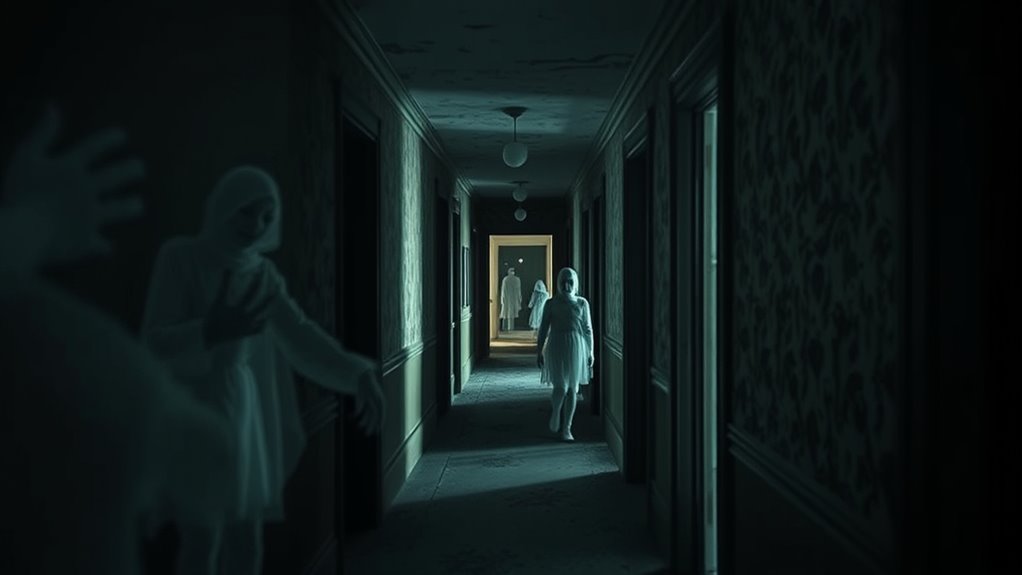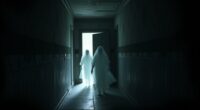Residual hauntings are like ghostly recordings, replaying past events without awareness or interaction, often triggered by environmental factors. In contrast, intelligent hauntings involve active spirits that respond, move objects, or communicate, showing signs of consciousness. To tell them apart, focus on behaviors—residual echoes stay fixed, while intelligent spirits engage with you. Keep exploring to understand more about what makes these phenomena so mysteriously different.
Key Takeaways
- Residual hauntings are repetitive energy imprints replaying past events, while intelligent hauntings involve active spirits responding to stimuli.
- Residual phenomena appear unaware of observers and do not interact; intelligent spirits can respond and move objects intentionally.
- Environmental triggers like time, location, and emotional energy activate residual echoes, whereas intelligent spirits react to questions and environmental cues.
- Scientific tools such as EMF meters and EVP recorders help distinguish between static residuals and conscious spirit activity.
- Cultural and historical contexts influence whether phenomena are seen as ghost replays or actual spirits.
Defining Residual and Intelligent Hauntings
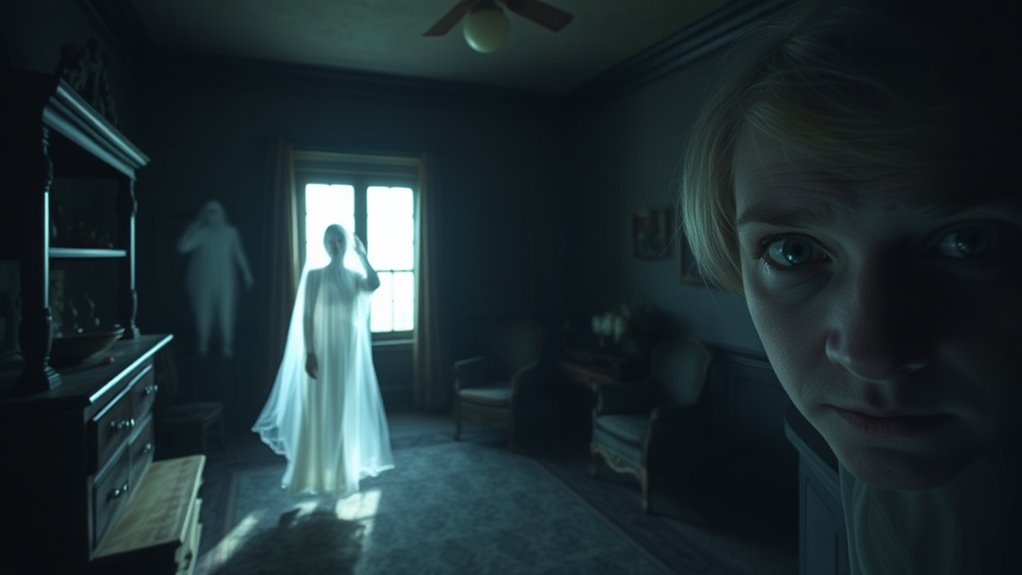
While both residual and intelligent hauntings involve spirits, they differ markedly in their nature. Residual hauntings are like psychic impressions or energy imprints left behind by past events. They replay scenes or sounds, much like a tape recorder capturing a moment in time. You might see a ghostly figure perform the same actions repeatedly, without awareness of your presence. These hauntings aren’t conscious entities but rather echoes of past energies imprinted into the environment. In contrast, intelligent hauntings involve spirits that are aware of their surroundings. They can interact, communicate, and respond to your actions. These spirits retain consciousness and may even attempt to communicate with you directly. Recognizing these fundamental differences helps clarify what kind of haunting you’re experiencing, especially when considering the mind-body connection involved in some types of spiritual phenomena. Additionally, recognizing the types of hauntings can aid in determining the appropriate approach for investigation or interaction. Understanding the energy imprints left behind in residual hauntings can help differentiate them from active spirits engaged in ongoing interactions. Exploring aura variations can also offer insights into the emotional and spiritual states associated with different types of hauntings. For instance, studying spiritual energy patterns may reveal underlying emotional disturbances linked to certain hauntings.
Characteristics of Residual Hauntings
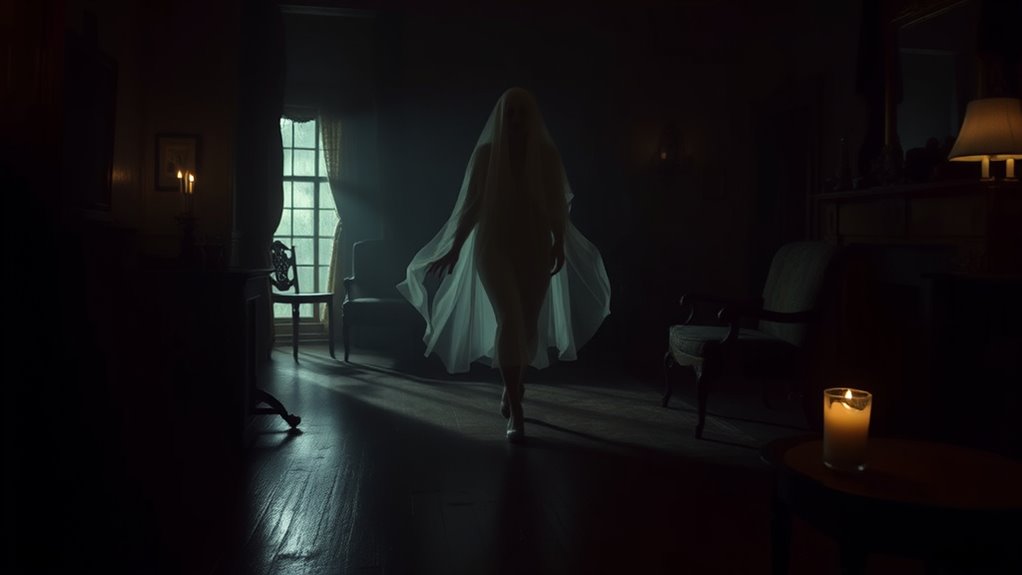
Residual hauntings are characterized by their repetitive nature, often playing out the same scenes or sounds without any awareness of your presence. These hauntings are like energy imprinting, where specific moments become etched into the environment, replaying under certain conditions. Environmental triggers, such as specific times of day or particular locations, can activate these residual images. You might hear footsteps or see apparitions that seem frozen in time, unaware of your existence. This type of haunting isn’t conscious or interactive but instead represents a recording of past events. Recognizing these traits helps differentiate residual hauntings from other types. They’re more like echoes of history, replaying endlessly without any intent or awareness behind the manifestations. Interestingly, some believe that these haunting patterns may be influenced by cultural celebrations, which can imbue certain locations with heightened emotional or spiritual energy, potentially affecting residual phenomena. Additionally, some researchers consider Environmental triggers as key factors that can activate these repetitive echoes, making understanding the surroundings crucial for identification. External factors such as environmental conditions might also contribute to the likelihood of residual hauntings occurring or becoming noticeable. The study of haunting patterns can offer insights into how environmental and emotional energies interact with physical spaces.
Traits of Intelligent Spirit Manifestations
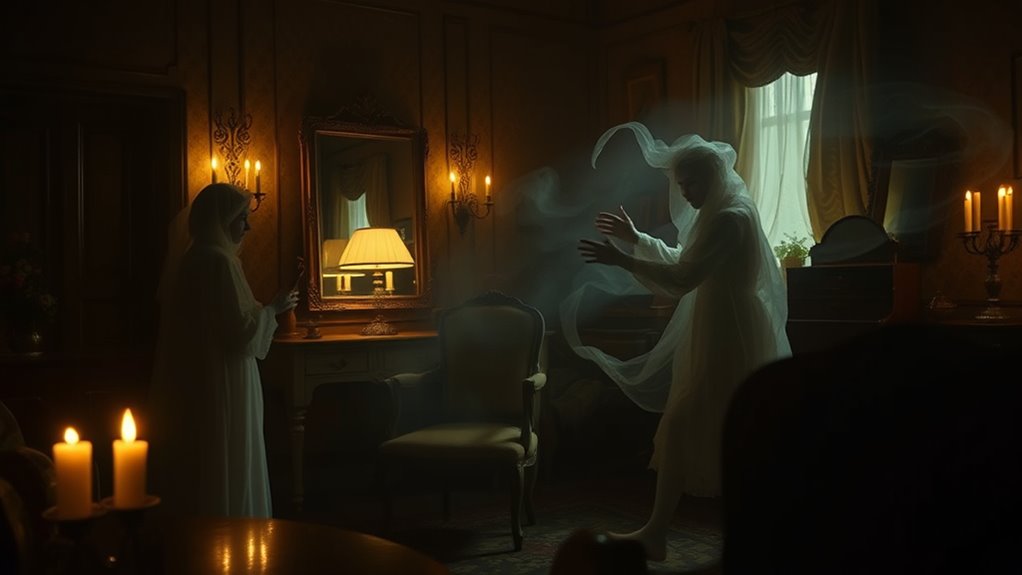
You’ll notice intelligent spirits often interact actively with their environment, showing signs like moving objects or responding to questions. They also display behaviors that make sense within their past lives or specific situations, giving clues about their identity or purpose. Recognizing these cues helps you understand that these spirits are aware and engaged, unlike residual energies. Residency requirements are a key aspect of identifying the legitimacy of such spirits, as they often relate to the location where the spirit is most active or connected. Additionally, location-specific energies can influence the presence and behavior of intelligent hauntings, indicating a strong link to their environment. Understanding the energy patterns associated with these spirits can further aid in distinguishing them from residual phenomena. Moreover, awareness of behavioral cues can provide valuable insights into their intentions or unresolved issues, especially when considering the environmental influences that shape their actions.
Active Interaction Signs
Active interaction signs are clear indicators that an intelligent spirit is present and engaging with its environment. You might notice the spirit responding to your emotional triggers or environmental influences, showing awareness of your presence. These signs often include sudden movements, direct conversations, or objects moving intentionally. Such interactions suggest a conscious effort to communicate rather than random phenomena. Recognizing the color accuracy of certain spirits or energies can help in understanding their intentions and origins. Understanding these signs helps differentiate intelligent hauntings from residual energy, emphasizing the spirit’s active engagement with its surroundings.
Contextual Behavioral Cues
Intelligent spirits often display specific behavioral cues that set them apart from mere residual energy. These cues are influenced by psychological factors and environmental influences, making their actions more purposeful. For example, they may appear in response to your presence or questions, demonstrating awareness of their surroundings. You might notice them changing locations or displaying behaviors that seem to have meaning, such as mimicking speech or reacting to your tone. These cues suggest a consciousness behind their actions, driven by intent rather than simply replayed energy. Environmental influences, like changes in temperature or sounds, can trigger or coincide with these behaviors. Recognizing these contextual cues can help you distinguish an intelligent presence from a residual one, reaffirming the spirit’s capacity for interaction and awareness.
Scientific Perspectives on Paranormal Activity
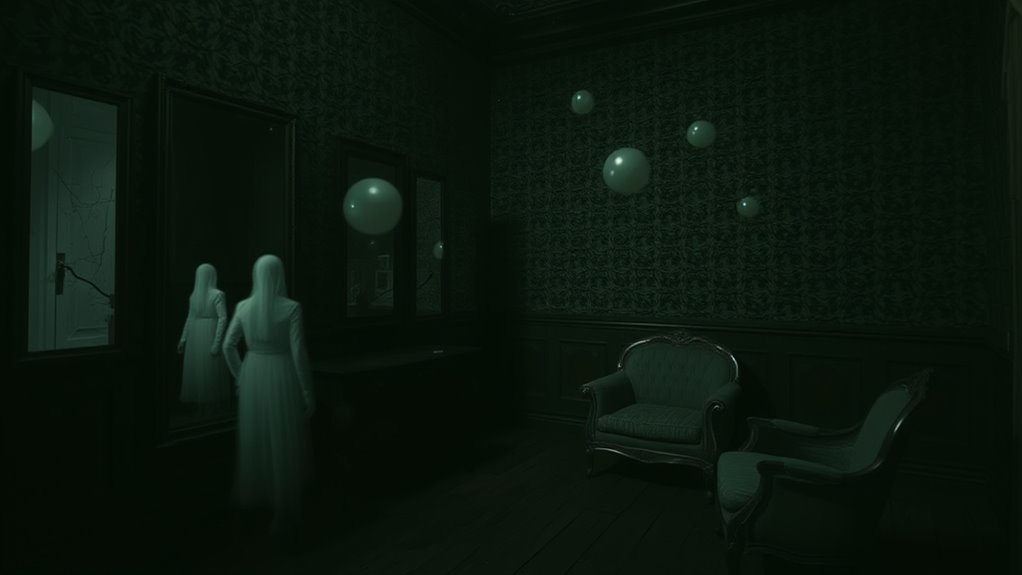
Although many people believe in paranormal activity, scientific research remains skeptical of claims that ghosts or spirits influence the physical world. Researchers explore natural explanations, such as changes in electromagnetic fields or the mind’s response to environmental stimuli. Quantum mechanics suggests that phenomena at the subatomic level may be misunderstood as supernatural, but evidence remains inconclusive. Studies show that electromagnetic fields can affect brain activity, potentially creating sensations of presence or hallucinations.
Scientific research questions paranormal claims, focusing on natural explanations like electromagnetic effects and brain responses.
- The mind’s sensitivity to environmental cues can mimic paranormal experiences
- Fluctuations in electromagnetic fields may influence perception
- Scientific inquiry seeks natural, measurable explanations before accepting supernatural claims
Common Types of Ghostly Encounters
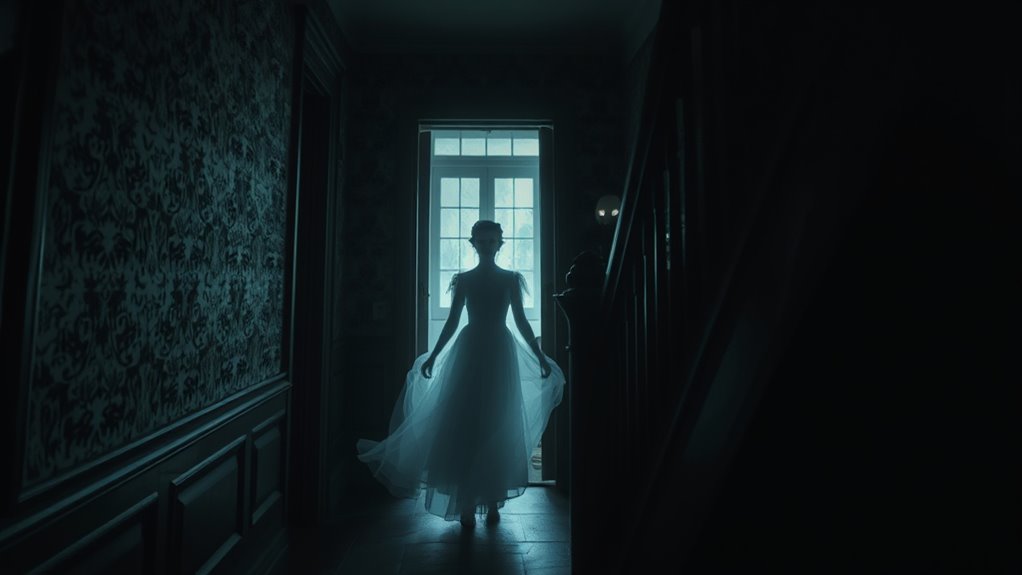
Many people who experience what they believe are ghost encounters report specific types of sightings and sensations that seem to defy natural explanations. Common encounters include seeing apparitions—translucent figures or full-bodied spirits—often described in paranormal literature and ghost folklore. You might hear unexplained footsteps, voices, or whispers that seem to come from nowhere. Feelings of sudden cold spots, touches, or a lingering presence are also frequent experiences. These encounters often occur in familiar locations like old houses, cemeteries, or places with historical significance. While some interpret these as residual energies replaying past events, others believe they could involve intelligent spirits capable of interacting with the living. Recognizing these typical ghostly encounters helps you understand the diversity of experiences reported across cultures and histories.
Technological Tools Used in Paranormal Investigations
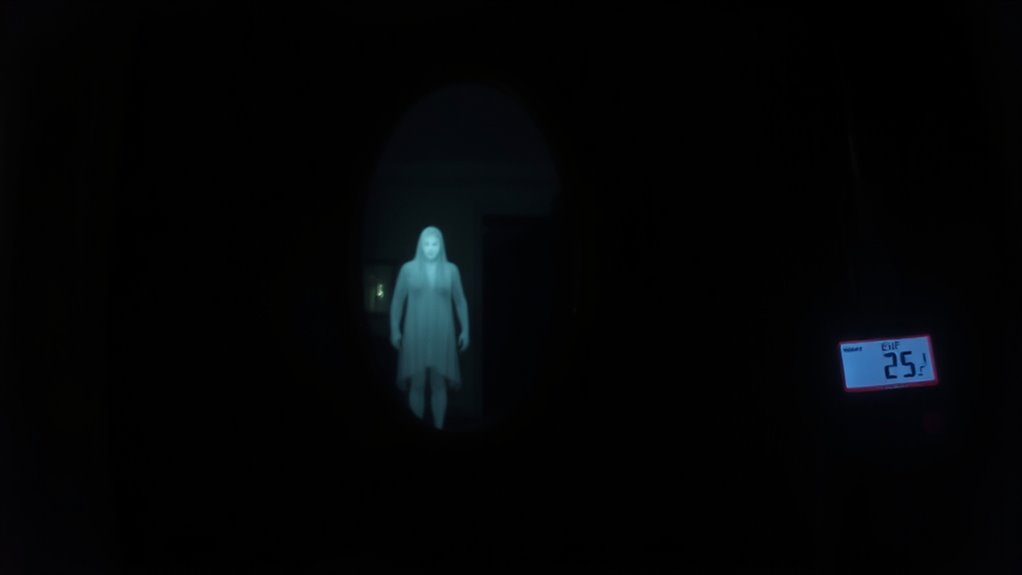
Paranormal investigators rely on a variety of technological tools to detect and document ghostly activity. These electronic devices help capture evidence that can be analyzed for patterns or anomalies. You’ll often see equipment like EMF meters, digital voice recorders, and infrared cameras in action. Data analysis is essential to interpret the information gathered and distinguish genuine paranormal signals from background noise. Understanding the role of these tools deepens your appreciation of the scientific approach to investigating hauntings.
- EMF meters identify electromagnetic fluctuations linked to spirits
- Digital voice recorders capture Electronic Voice Phenomena (EVP)
- Infrared cameras reveal temperature changes and visual anomalies
These tools provide tangible evidence, making the investigation more objective and credible. They serve as modern extensions of traditional methods, bridging science and the supernatural.
Cultural and Historical Accounts of Hauntings
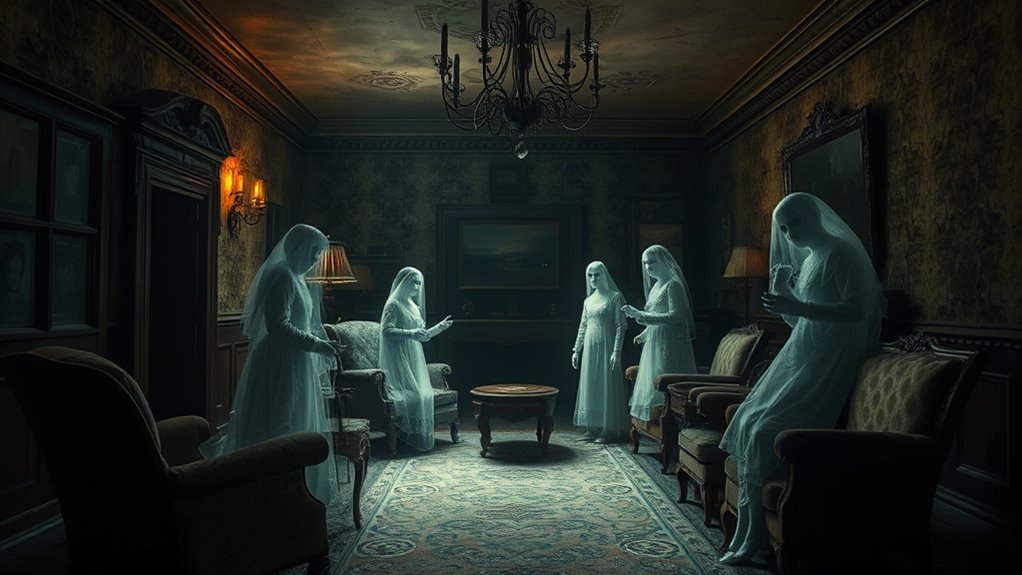
Throughout history and across cultures, hauntings take on different meanings and appearances that reflect local beliefs and traditions. You’ll notice how stories of spirits often stem from significant events or societal values that shape their narratives. Understanding these cultural and historical influences helps clarify why certain hauntings are believed to persist or change over time.
Cultural Variations in Hauntings
Have you ever wondered how different cultures perceive and interpret hauntings? Cultural symbolism and regional beliefs shape unique ghost stories and experiences worldwide. In some societies, spirits represent ancestors watching over loved ones, while others see hauntings as punishments or warnings. These variations influence how people respond to and explain supernatural encounters.
- In Asian cultures, spirits often embody moral lessons or serve as guides, reflecting deep-rooted spiritual values.
- Western legends frequently depict ghosts as restless souls seeking closure, highlighting cultural notions of justice.
- Indigenous beliefs may interpret hauntings as messages from the land or ancestors, emphasizing a close bond with nature.
Understanding these cultural differences helps reveal how regional beliefs influence perceptions of hauntings, emphasizing that what’s interpreted as a residual or intelligent haunting can be deeply rooted in cultural symbolism.
Historical Events Shaping Spirits
Historical events often leave behind stories of spirits that continue to influence cultural perceptions of hauntings. These accounts shape how societies interpret paranormal phenomena, blending spiritual symbolism with historical trauma. For example, battles and tragedies often result in ghost stories that reflect collective fears and hopes. Understanding these stories through paranormal psychology reveals how cultural context shapes our view of spirits. The following table highlights key historical events and their spiritual symbolism:
| Event | Spirit Connection | Cultural Impact |
|---|---|---|
| The French Revolution | Spirits of fallen revolutionaries | Symbolize freedom and chaos |
| Haunted Battlefields | Echoes of soldiers’ unrest | Represent unresolved conflict |
| Historic Mansions | Residual energy of past occupants | Embody wealth, decline, or tragedy |
These stories demonstrate how history influences our beliefs about whether spirits are residual echoes or intelligent entities.
Debating the Reality: Are These Phenomena Genuine?
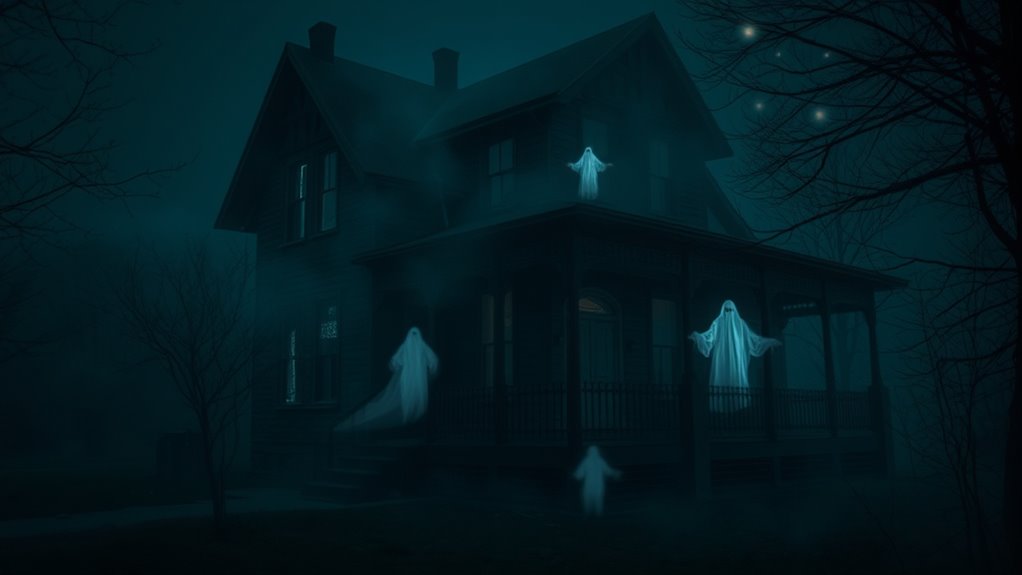
The debate over whether residual and intelligent hauntings are genuinely real hinges on contrasting interpretations of unexplained phenomena. Some see these experiences as evidence of spirits, while others rely on scientific skepticism, attributing them to psychological or environmental factors. Your beliefs influence how you interpret these events—whether as genuine paranormal activity or illusions created by the mind. To understand the debate, consider these points:
- Paranormal skepticism questions whether emotional or cognitive biases distort perceptions.
- Scientific skepticism emphasizes empirical evidence and reproducibility.
- Personal experiences alone often lack the rigorous proof needed to confirm the phenomena’s authenticity.
Ultimately, the question remains: are these hauntings real spirits or just vivid memories and perceptions shaped by unseen influences?
The Future of Ghost Research and Understanding
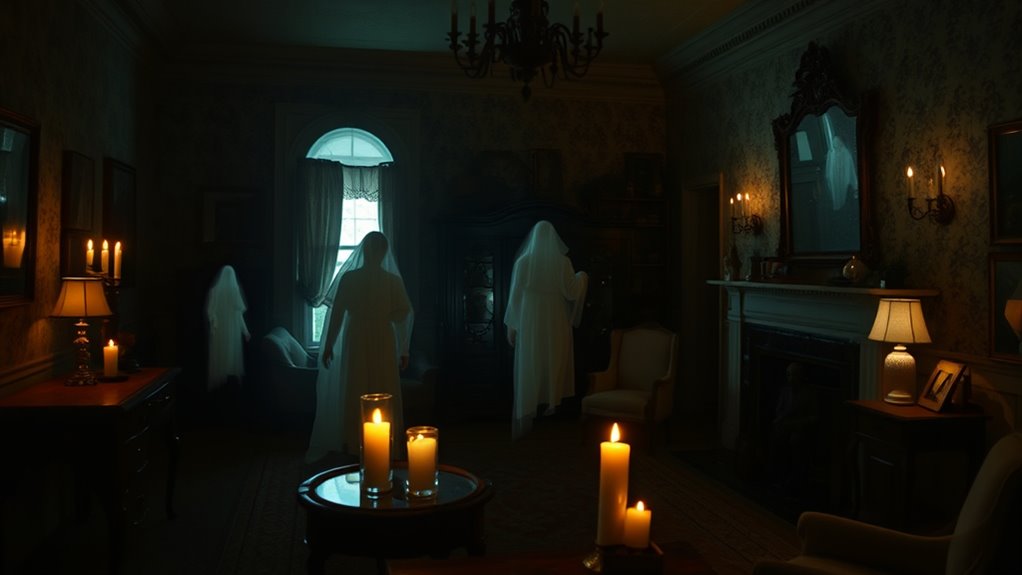
Advancements in technology are poised to revolutionize how you study and understand hauntings, moving beyond traditional anecdotal reports toward more scientific approaches. Quantum theory offers promising insights, suggesting that consciousness may be interconnected with the fabric of reality, potentially explaining some haunting phenomena. As consciousness studies progress, researchers can explore whether spirits are residual energy patterns or actual intelligent entities interacting with our world. High-tech tools like EMF sensors, infrared cameras, and even brainwave analysis could shed light on these mysteries. Future research might uncover whether consciousness persists after death or if certain environments trigger residual impressions. This scientific push aims to bridge the gap between skepticism and belief, ultimately deepening our understanding of what truly constitutes a ghost.
Frequently Asked Questions
Can Residual Hauntings Occur Without Any Human Presence?
Residual hauntings can occur without any human presence, based on historical context and environmental influences. You might not see a living person, but the energy of past events can leave a lasting imprint. These echoes replay scenes from history, like a tape loop, triggered by environmental factors such as temperature, moisture, or sound. So, even in the absence of humans, residual hauntings can persist, creating haunting impressions of what once transpired.
Are Intelligent Hauntings More Common in Certain Geographic Regions?
You might think intelligent hauntings are evenly spread, but surprise—geographic clustering suggests they’re more common in areas rich with regional legends. Certain regions seem to attract these active spirits, possibly due to local history or folklore fueling their presence. So, if you’re hunting for intelligent hauntings, start digging into local stories; your chances might just get a supernatural boost where legends run deep and spirits play hide-and-seek nearby.
How Do Paranormal Investigators Differentiate Between Residual and Intelligent Hauntings?
To differentiate between residual and intelligent hauntings, you observe energy signatures and behavioral patterns. Residual hauntings often show repetitive scenes with no interaction, like a tape replay. In contrast, intelligent hauntings involve dynamic interactions, where spirits respond to your questions or actions. As a paranormal investigator, you note these signs, focusing on whether the energy signature is static or responsive, helping you determine if you’re dealing with a ghost replay or a real spirit.
What Psychological Factors Influence People’s Perception of Ghost Encounters?
When you perceive ghost encounters, your mind is influenced by cognitive biases like pattern recognition and confirmation bias, which can make you interpret ambiguous stimuli as paranormal. Cultural influences also shape your beliefs and expectations, shaping how you interpret eerie experiences. These psychological factors can lead you to see spirits or residual energies, even when there’s no objective evidence, highlighting the power of your mind in paranormal perception.
Are There Any Known Physiological Effects Caused by Ghostly Phenomena?
Imagine feeling a sudden chill or your hair standing on end as ghostly phenomena unfold. These experiences can trigger psychological effects like fear and anxiety, which in turn cause physiological responses such as increased heart rate, sweating, or trembling. While some effects are emotional, others are physical, revealing how ghost encounters can deeply influence your mind and body, making the experience both haunting and real.
Conclusion
Ultimately, whether you believe residual or intelligent hauntings, exploring these phenomena pushes you to question what’s real. Scientific tools might not prove spirits yet, but they deepen your curiosity. Theories like residual energy suggest ghosts are echoes of the past, while others see intelligent spirits as conscious beings. Trust your experience, but stay open-minded—ghosts may be more than just stories. The truth remains elusive, inviting you to keep searching and questioning what lies beyond the physical domain.
